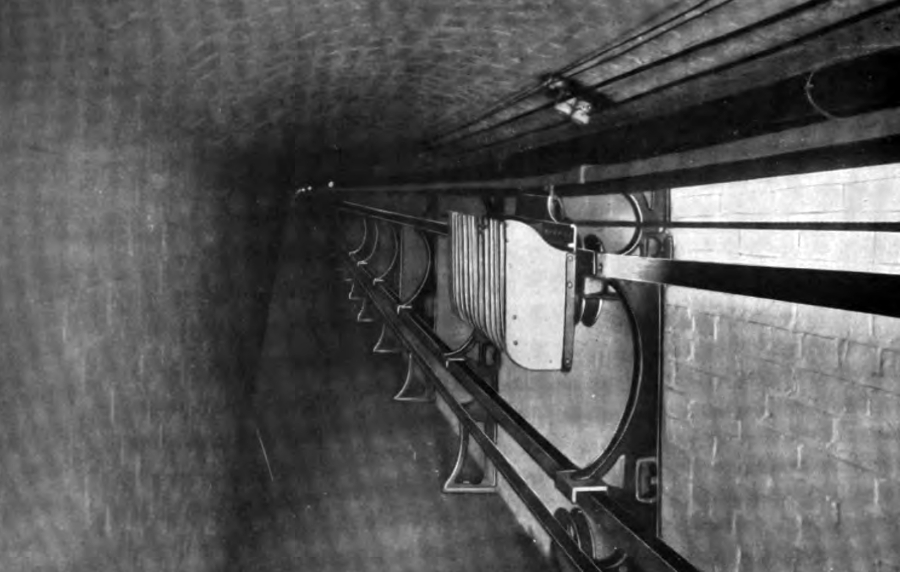bOOK CONVEYING APPARATUS AT THE JEFFERSON BUILDING. SCIENTIFIC AMERICAN PHOTO
By Elliot Carter
The Library of Congress occupies three large buildings across 25 acres on Capitol Hill. As the facilities expanded over the past century Congress has requested new solutions to maintain easy access to their reading material. The result are several interesting conveyor systems, in varying state of operation and disrepair, all designed to shuttle books around the complex.
The Book Tunnel
In 1897 the Library of Congress moved across First Street from a room in the Capitol to the newly completed Jefferson Building. Members of Congress balked at the idea of constantly hiking back and forth, so the Army Corps of Engineers built a special tunnel to transport books between the two buildings.
A "book conveying apparatus" in the tunnel "noiselessly" whisked books back and forth at 600 feet per minute. Mary Simmerson Cunningham Logan (wife of Civil War era Sen. John Logan) describes the system in her 1901 history of Washington. With the book tunnel, “a Congressman can get the volumes he desires in less time than it would have taken him when the Library occupied its old quarters in the Capitol itself" writes Logan. "If in the midst of a speech it occurs to a Senator that he needs a certain book or the file of a certain newspaper, he has but to call a page, whisper his wish, and before he has delivered many more sentences, the page returns with the book or file.”
Central Distributing Desk
The distributing desk in the Jefferson Building's Main Reading Room operated as the central hub in the system. A request would come in from the Capitol via pneumatic tubes that used to connect the two buildings. The books would arrive via a separate but similar conveyor system that linked the desk with the dozens of miles of shelving in the north and south stacks.
The books would descend down to the tunnel room through a dumbwaiter located in the boxy central cabinet. Then they got placed on the Capitol carrier and whisked away. The cabinet also housed a little stairway so staff could easily travel between the distributing desk and the tunnel room.
Logan describes how the conveyor system also worked in reverse. "When the book is to be returned, the attendant at the distributing desk sets a little lever on a dial at the number of the stack in which the book belongs, and when the tray approaches the proper floor, the slide is automatically pushed out to receive the load. Thus every day and every evening, hundreds of books are noiselessly traveling to and fro, north and south, up and down, from stack to reader and from reader to stack. "
The Adams and Madison Buildings
Newer second and third generation book conveyors connect the Jefferson building with the two Library of Congress annex buildings (built in 1939 and 1980).
The original Jefferson system was essentially a point A to point B circuit; the newer ones were more elaborate. Every department and reading room had its own address, and you could request or dispatch books from terminal stations built into the walls.
RECIEVING STATION IN THE MADISON BUILDING. ELLIOT CARTER PHOTO
Tubs of books traveled around the library complex on a conveyor belt housed in ducts hanging from the ceiling. You can still see the ducts down in the pedestrian tunnels that connect the different buildings.
What's Left
Half of the old Jefferson Building book tunnel was destroyed in the early 2000's to make way for the subterranean Capitol Visitor Center under the east front. The library half of the tunnel was bricked up and abandoned in place.
A recent visit to the Library of Congress showed that the pneumatic tubes and the internal Jefferson building conveyors have also been removed. However, the dumbwaiter cabinet is still in operation and an employee reported that it was actually refurbished "a few months ago."
The Adams and Madison building conveyors were taken out of service years ago because sections kept breaking down. With the rise of the internet there are far fewer requests for physical books at the Library of Congress. Unfortunately, an investigation determined that it would not be cost efficient to keep doing repairs. Additional factors counting against the conveyors were the occasional damage to books, and losses resulting from human error with the destination codes.
Some sections of the tunnel ductwork have been removed but most of it is still there. Like the inoperable mail chutes, telephone booths and other technology that has been abandoned in place on Capitol Hill, they're frozen between the forces of bureaucratic inertia and historical preservation.
Book requests at the Library of Congress have come full circle, and today's librarians have to make their deliveries by hand.
hand delivery at the LC. Book conveyor vent visible above. Elliot Carter Photo







